5 Things You Should Consider Before Buying Power Tool Batteries
We may receive a commission on purchases made from links.
A battery in a wireless power tool is a fundamental addition that keeps these robust tools working efficiently as you work on any project, either one at home or in your professional life. A powerful tool with a battery provides you with additional freedom not to feel tied down to working only where an outlet is nearby. Although these batteries might be more convenient, they do have their drawbacks, such as failing or entirely running out of energy, forcing you to recharge or replace them. When this happens, there are a few things you need to consider about what type of battery to acquire next.
Before you dive into learning about these batteries, it also helps to do some research about the power tool you're using. For example, knowing that you can't use batteries from one power tool brands on another, as they don't all work the same. Even though there are third-party adapters that allow you to do this for power tools with almost every major tool brand, it's not recommended. We'll be listing out the most important things you should learn about a power tool battery and what you should be asking yourself before you buy one.
What is the budget for your project?
Keeping track of your budget is an important thing to do for every construction project, whether you're a professional or you're doing something for your home. It's a good idea to keep track of how much you can spend, and also to figure out what type of project you're going to be doing when picking out batteries for your power tools.
For example, those who are working long hours, nonstop, should consider investing in batteries with a higher amp-hour (Ah) rating, as it represents a battery's runtime before you need to charge it. A two-pack of Dewalt 20V 2Ah batteries can run you $90, with varying battery lifetime based on the type of tool you're using. A 2Ah is ideal for smaller power tools, like compact drivers. If you're planning to use a saw or an angle grinder, you might want something more substantial, like a 5Ah, but they're more costly, with a pack of two Dewalt 20V 5Ah batteries costing $169.
On top of knowing the cost of buying a powerful battery, tracking down a robust charger is also useful. If you only need one or two batteries, then the single-slot charger, like the 20V Max Battery Charger for $29.99, should be fine, or you can go with a Dual-Port Charger for $119.00. These are vital details that you want to consider before diving deep into a project.
What is the voltage of the battery?
You always want to match a battery's voltage with a power tool that has the exact same voltage requirement. The best-known power tool manufacturers offer 12V, 18V, 20V, and 36V models (although 18V and 20V batteries are effectively the same). So even if the batteries are the same brand, they won't work for every cordless power tool crafted by that manufacturer.
For example, you don't want to use a Milwaukee 12V battery on an 18V Milwaukee M18 tool — even if the battery fits — since the battery won't supply enough voltage. When a power tool doesn't have enough charge from a lower voltage, it won't perform as effectively as you want, and the battery could damage itself. The same applies to using batteries with a higher voltage than the tool is rated for, as you can cause chemical and thermal damage to your tools. Between the two, over-voltage is far more dangerous, as this can cause damage to internal circuit boards through overheating, or there's the chance for the tool to fail instantly. Even though it is challenging to use an incorrect battery on a power tool, it's essential to remain mindful of this whenever working on a project.
Does the battery have a charging station?
Another critical factor to consider when purchasing a power tool battery is whether your purchase comes with a charging station or not. While off-brand chargers are available for many batteries, using the same brand ensures it receives the best charge possible and reduces the likelihood of failure. You want to remain in the same brand as your battery, and you want to figure out if you want a fast or slow charger, which range in price and time of recharging your tools. The most significant difference between slow and fast chargers is the amount of amperage they apply to the batteries, as fast chargers provide more, which generates more heat and potentially consumes batteries faster. However, modern innovations have curbed most of these negative effects, for a price.Slow charging stations are more cost-effective than fast ones, as some of the larger power stations are pricey.
If you need to purchase a charging station separately, consider what additional features come with it. You might want one with a display to show how much charge a battery has while it's plugged in, or how long you have to wait until it's fully charged. Look for overcharging or short-circuit protection, which prevents the battery from being damaged, particularly if you leave it plugged into the station for extended periods of time. Also consider the warranty offered by the manufacturer, which should enable you to replace the charger if anything goes wrong.
How much weight does the battery add to your power tool?
Cordless power tools offer convenience and portability, but their batteries add weight when compared to corded versions. This can affect the quality of the work being done, as a heavier tool may be more challenging to keep in place and feel less comfortable to use. Furthermore, even if you've matched a battery's voltage and brand to your power tool, there's another variable that can make a significant difference to its weight: the amp-hours of a battery, which measure a battery's total charge capacity.
A DeWalt 20V Max 5Ah is going to be lighter than the 20V 12Ah models, although the 5Ah won't be able to hold as much charge and so won't last as long as the 12Ah ones, similar to using a 4Ah battery over a 6Ah. However, a 5Ah battery might be a better option for you if you're regularly bringing the power tool with you up to high places, or if you're just carrying it around a lot.
Does the battery have safety features?
It's always worth checking what built-in safety features a battery includes, which protect the battery and power tool during charging and while in use. These features should include protection against overheating, as well as overcharging and short-circuiting protection when plugged into a charging station. It may be preferable to charge your power tool batteries before storing them, but overcharging a power tool battery is a common mistake that can ruin a battery.
There are other steps you can take to keep your batteries safe and prolong their lifespan, so they continue to keep working optimally for long after their purchase date. When you're not using a power tool battery, disconnect it from the tool and keep it in a dry, cool location alongside the charging station. You don't want to keep them in an area where they could be exposed to liquids or oils, and away from extreme temperatures.





